

SCALES in the Programs of AVS

1.1. "Classic" version of truck scales
1.2. Automatic car identification

2.1. Platform scales for receiving raw materials and packing finished products
2.2. Warehouse rent, customs warehouse
2.3. Platform scales in plastics processing
2.4. Fertilizer mixing on a platform scale

3.1. Automated workstation with floor scales
3.2. Using AWS for automating meat processing.
3.3. Using floor scales for crop accounting

1.1. "Classic" version of truck scales
Fig. 1.
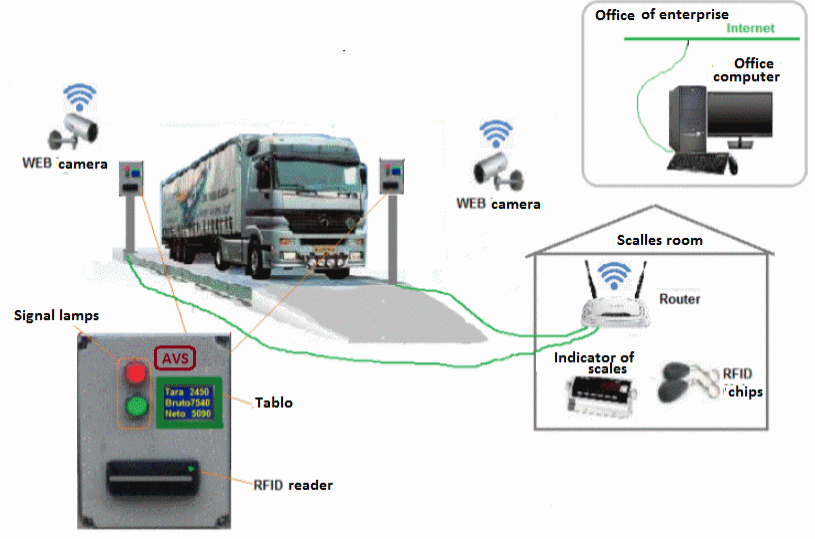
The scale is equipped with an AVS electronic unit that fits at the shoulder level of the driver at each end of the scale. When the car enters the scale, the driver scans the TEG RFID (Radio Frequency Identification) (Chip) on the reader installed on the AVS unit. After reading the Chip code, the program receives the stabilized weight readings from the scales indicator located in the electrical box near to the scales, in the scales control box, in the weighing room or in the office of the Enterprise. If the car with the chip is identified for the first time, the Program does not yet "know" what kind of weight it is. If the car has delivered the cargo, it is unloaded, and the car enters the scales a second time and identifies itself with the help of the Chip. The program calculates and records the Net weight of the load. Scales of Gross, Tare and Net are visible to drivers on the AVS electronic unit . Program operator enter document type and product type into the Program what is delivered or will go away. The document is automatically sent electronically to the accounting department of the Enterprise. If the product to be taken away or coming and is homogeneous or it is known which product is being moved by a particular car, the Program can work without operator participation and perform the work of a dispatcher in the "robot" mode.
1.2. Automatic car identification
Fig2.
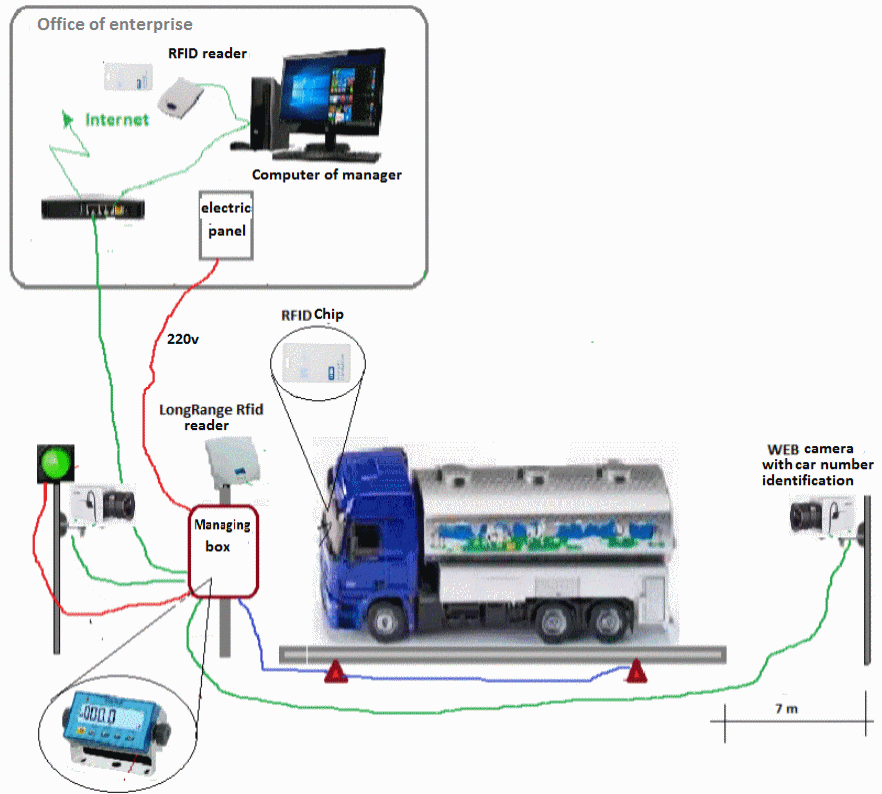
In difference to the one shown in Fig. 1 above you can see LongRange - chip reader which “see” cheeps from a long distance. The chip is located in the cab of the car. When the car is going onto the scale, the chip is read automatically. Such chips can be issued on a permanent basis to enterprise drivers and temporarily to drivers of other companies vehicles. In the second case, the driver returns the chips to the enterprise's office after finishing the weighing procedure.
LongRange readers can be replaced with webcams with automatic identification of license plates. In this case, the vehicle is also identified automatically. Using these webcams can cause problems if the car number plates are not clean. For such cases, the Program provides input of the vehicle number in the "manual" mode.
In both cases of automatic vehicle identification, the functionality and application of the Program correspond to those described in clause 1.1 of the "classic" case.
2.1. Platform scales for receiving raw materials and packing finished products
Fig.3

In fig. 3 shows three platform scales. The first and second ones serve for weighing raw materials, thus, its quantity is checked and compared with that specified in the incoming invoices. To speed up the acceptance process, the forklift drives on the scales with a bale of raw materials. The forklift driver enters the required information on a touchscreen near to the scale and automatically weighs the entire load. To determine the Net weight, the weight of the loader and its driver is subtracted from the total load. At the end of production, large bags of finished products are automatically weighed and marked on a third scale. Information on incoming raw materials and on the quantity of marked finished products is automatically transferred to the accounting system. It should be noted that bales are tagged with RFID (radio frequency identification) chips for automatic raw material inventory too. RFID chips in stock and in manufacturing are identified by LogRange (remote control) and portable antennas (readers). Scales and chip readers connected to the Program can significantly reduce routine accounting work.
2.2. Warehouse rent, customs warehouse
Fig.4

When the warehouse Tenant brings his goods for storage, the pallets are placed one by one by forklift on the platform scales. Prior to that, the Tenant's cargo accompanying document was inputted into the AVS Program at the company's office. If there is no data on the Tenant or the product in the Program database, it is entered. When the pallet is on the scales, the forklift driver selects the Tenant and the goods on the pallet on his tablet and gives the Program a command to weigh the pallet via the cloud connection. Using the weighing results, the program prints a pallet mark with a unique pallet number (in the example 815), the names of the Tenant and the cargo, as well as the date of arrival of the pallet on the laser printer. The program "offers" the forklift driver to place the pallets of one tenant together, if possible. The user of the program can also set special, for example, flammable goods to be placed in a special storage area.
As a result of automated pallet weighing, the warehouse manager knows how many pallets, how many and what goods are in the warehouse for each of the Tenants. It helps to prepare monthly invoices for the storage of goods, if they are invoiced in tonnes and days of storage or depending on the m2 of warehouse space occupied. The program helps to forecast the warehouse load, if the Tenants announce the planned removal of the goods from the warehouse when placing the goods for storage
At the delivery of goods, pallets are weighed to make sure that pallets and packaging are preserved.
A WEB camera can be placed at the weighing zone and the appearance of the pallet can be photographed upon entering the warehouse. The photo as a media file is so attached to the information about the pallet and can be useful in case of disagreements that may occur when the Tenant receives his goods from storage. The system can be supplemented with a bar code scanner. In this case, its unique number is printed on the pallet marker in the form of a bar code. The tracking of the forklift driver will be improved if LongRange (long distance) bar code readers are used. The driver can then scan the pallet bar codes without leaving the truck sit.
2.3. Platform scales in plastics processing
Fig.5

In fig. 5 shows how the platform scales are used at automated workstations (AW) for the processing of plastic materials. The first scales are used to weigh incoming raw materials. In addition, when the bales of raw materials are on the scales, the moisture content of the raw materials is determined by a special meter. Moisture measurements helps determine the “dry residue” of raw materials (waste plastics). This adjusts the incoming invoices and correct the amount of raw material what is delivered to the warehouse without moisture.
AW2 prepares different additives according to different recipes. The program operator, knowing what products and how much will be produced. With the help of the Program determines the amount and composition of the necessary additives using simple manipulations on the touch screen. A Program in a computer connected to the scale calculates and suggests which chemicals need to be added to the additive dose. When additives in the right proportions are placed in special bags, they are marked with a unique recipe bar code. This bar code is scanned when the main raw material - dry plastic waste along with additives is loaded into mixers (Mix1, Mix2). Both the main raw materials and additives are written off from the warehouse upon the fact of their use.
At the end of the production process, the finished product is weighed on a second platform scale. Products are raw materials for the production of plastic things. Depending on the weight of the big bag, the finished product is marked with EAN weight bar codes. The label on the bag contains all the necessary information - the manufacturer, the name of the product in the required language, its weight, date of manufacture, series and other information. Data terminal (Bartender) is used to prepare outgoing waybills.
All documents prepared by AW1-5 are recorded and submitted electronically to the accounting department of the enterprise. In this case, there was the AXAPTA accounting system.
2.4. Fertilizer mixing on a platform scale
Pic.5-A
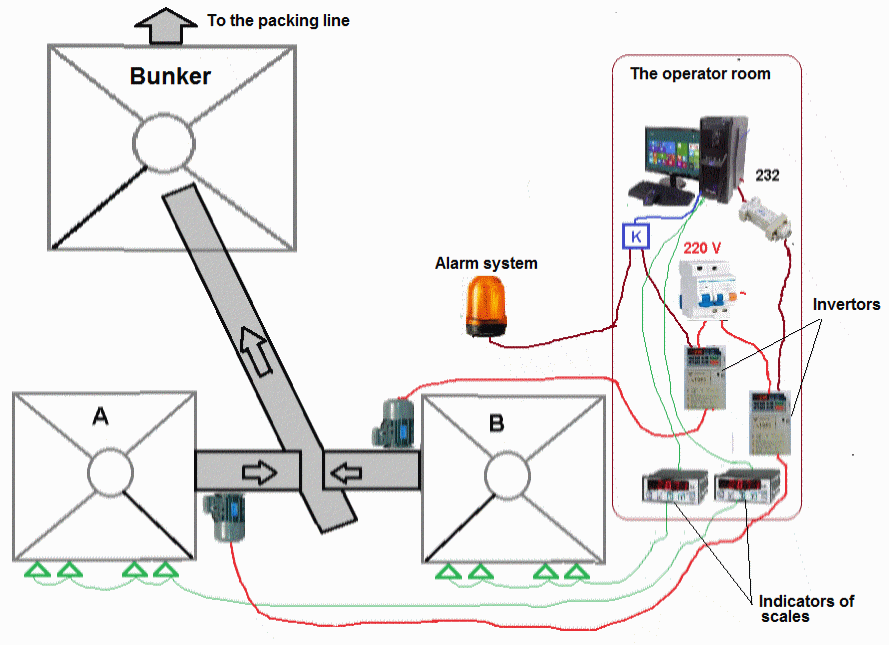
Figure 5A shows that two fertilizer bins have been placed on load cells and turned into a platform scale. The task of this Automated Workstation (AWS) is to supply the fertilizer to the Bunker from bunkers A and B in a strictly specified proportion. To do this, the AWS checks the taking of fertilizers from the bins by changing their weight and, with the help of inverters, changes the speed of the conveyors. Thus ensuring the specified proportion. In addition, the AWS, using feedback, quickly reacts to clogging of the conveyors due to lumps of fertilizers. If the proportion cannot be achieved due to clogging of the conveyors, the program stops the system with a message about the need to clean the conveyors. In addition, the system automatically stops if any of the bunkers (A or B) starts loading fertilizers. Because it does not allow to accurately determine the weight of the fertilizer taken from the hopper.
The system works without the participation of the program operator if high-quality and dry fertilizers are supplied to the bunkers A and B.
3.1. Automated workstation with floor scales
Fig. 6

Figure 6 shows a typical automated workstation (AWS) with floor scales and a tablet operating in the cloud. Although the tablet's webcam can be adapted for reading bar codes, it is not so convenient to use this possibilities in warehouses and production shops. Therefore, it is recommended to use a Blue Tooth (wireless) bar code scanner connected to the tablet.
AWP can be used in the following cases:
- if incoming packages of goods are marked with the bar code of the goods to be weighed on scales. On the tablet operator of AWS enter the incoming invoice. All packages markers are scanned. Then or before operator of AWS input in tablet supplier of goods. This can be done later in the incoming invoice created by the AWP and visible on the office stationary computer too. Prices of goods can also be entered there. The incoming document created on the AWS is compared with the paper or electronic document received from the supplier along with the goods;
- Outgoing invoices are created in the same way. By scanning the bar codes of the goods to be weighed, if they have been printed and sticed on the packages of goods in advance. The buyer of the goods is selected on the tablet. The program offers recommended sales prices, which can be changed as needed. After all packages of goods are scanned, the outgoing invoice is ready. It can be printed on a printer or sent electronically to the buyer of the goods;
- the most efficient use of AWS is to create an act of acceptance of finished products in the production shop. This is done by placing a package of manufactured goods on the scales and choosing the type of documents on the tablet. In this case a production act. The program reads the weight of the package from the scales, generates and prints a label with the bar code of the package on a printer connected via Wi-Fi (wireless) or Ethernet (shown in Fig. 6). In addition to the name of the product and its weight, other necessary information can be printed on the label - expiration date, storage conditions, product composition, series and other additional information that meets the requirements for various categories of goods. It should be noted that the accounting of packages on conveyors is organized differently. Its use stationary scanners, motion sensors and other technical automation solutions are used there;
- Other types of warehouse documents can be prepared in AWS - acts of write-off and inventory, internal transfer invoices.
Combinations of AWP capabilities are widely used for accounting and control of various production processes. This will be shown below.
3.2. Using AWS for automating meat processing.
Pic 7
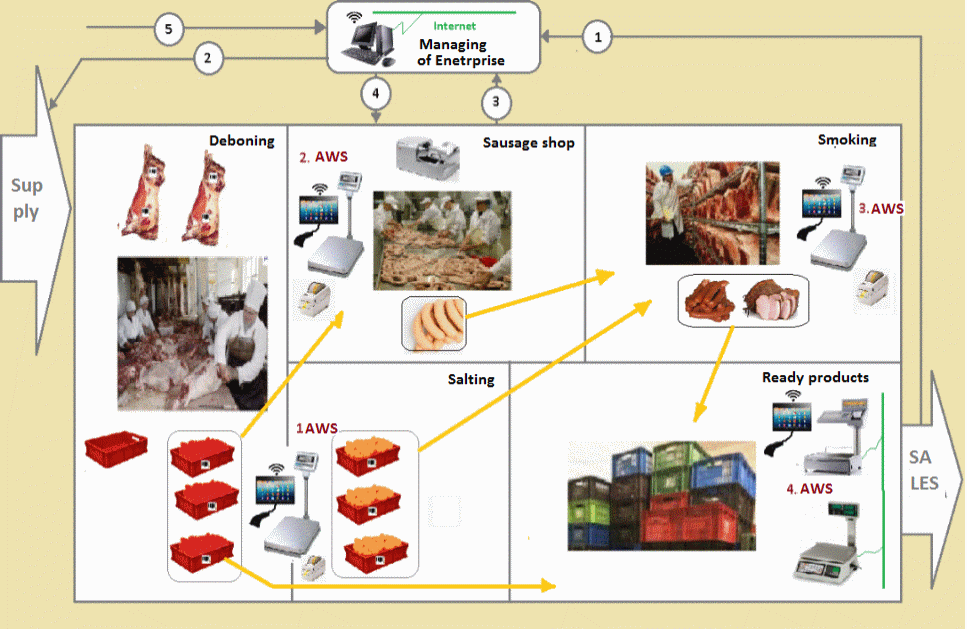
Figure 7 shows how workstations with floor scales are used in various combinations of meat processing:
- in the deboning area at 1.AWS the operator shows on the tablet what carcass he will use for deboning. Operator use an incoming invoice. Invoice shows the origin of the carcasses, their unique batches, or ear tag or registration number (for cattle's) or farm code (for pigs carcasses) where the livestock were raised (lot code). This is necessary to be able to trace the feedstock throughout the entire meat processing process. When the carcass is cut and its individual offal is placed in boxes it are placed on floor scales. Scales, tablet and bar code printer for all workstations are combined into a common automated control system (ACS). This allows to print labels for the boxes for semi-finished products with unique special EAN bar codes (European product numbering) for goods counting by weight. These codes are associated with carcass lot codes. Thus, after deboning, the markers on the boxes show which carcass the semi-finished product is made from. Labeled raw semi-finished products can be transferred to a sausage shop or finished product warehouse for sale in stores or at the market;
- in the salting area part of the raw semi-finished products on the same 1.AWS turns into another product - salted semi-finished products. The boxes with salted semi-finished products are marked again in the same order as it was done during deboning. 1.АWS is used at this two sites in terms of cost savings. For salting common scales, a tablet and a barcode printer can be used. The operator of the program on the tablet uses a scanner to show which raw meat products are selected for salting. Thus, the code of the weighed already salted meat is associated with both the unique batch code of the deboning meat and the carcass lot code. The traceability of raw materials continues;
- For the production of sausages at 2.AWS, lots of raw meat are selected by scanning the barcodes on the boxes. In the production of sausages, series of other components are also taken into account - sausage casings, additives and spices. Crates of raw sausages are also weighed and labeled before smoking. A raw sausage marker through the used raw meat codes is associated with the carcass lot. Thus, even after the deboned products have been used, traceability of the feedstock is ensured;
- The smoker accepts used salted meat and raw sausages also by scanning the markers of these semi-finished products boxes. Smoked products on the 3.AWS, as well as the 1st and 2nd, are weighed and labeled with an indication of which semi-finished products they were produced from. Thus, through the codes of semi-finished products, the marker of the finished smoked product is tied to the unique code of the carcass lot too;
- At the finished product warehouse, using 4.AWS, raw and heat-treated meat intended for sale is packed in boxes and vacuum packaged and mapped. On 4.AWS, EAN barcodes of piece or weighed goods are used, suitable for scanning on cash registers of stores. Finished product codes are also virtually linked to unique carcass lot. Thus, in the meat production process, a comprehensive traceability of raw materials occurs.
It should be noted that the use of AWSs and markers allows to control the shelf life of meat products throughout the technology. The markers also have a detailed description of the composition of the goods, the conditions for their storage and use. The warehouse program, which is the basis for AWSs, contains information about the cost of raw materials and the total cost of each product. This can be obtained by entering additional accounting information on production overheads into the warehouse program. If the company uses the Balance program of the warehouse developer (AVS), then no additional information is needed to enter. It will be used automatically. By entering the labor consumption rates in the calculation, based on the information from the AWSs, user of Program can get the calculation of the wages of workers in all areas, if the company uses piecework wages.
In fig. 7 shows that with the help of AWAs the management of the enterprise, using the information received from AWSs, on the information channels 1,2,3,4,5. can effectively manage production processes using feedbacks 1-2, 3-4. You can read more about this here ..
3.3. Using floor scales for crop accounting
Figure: 8
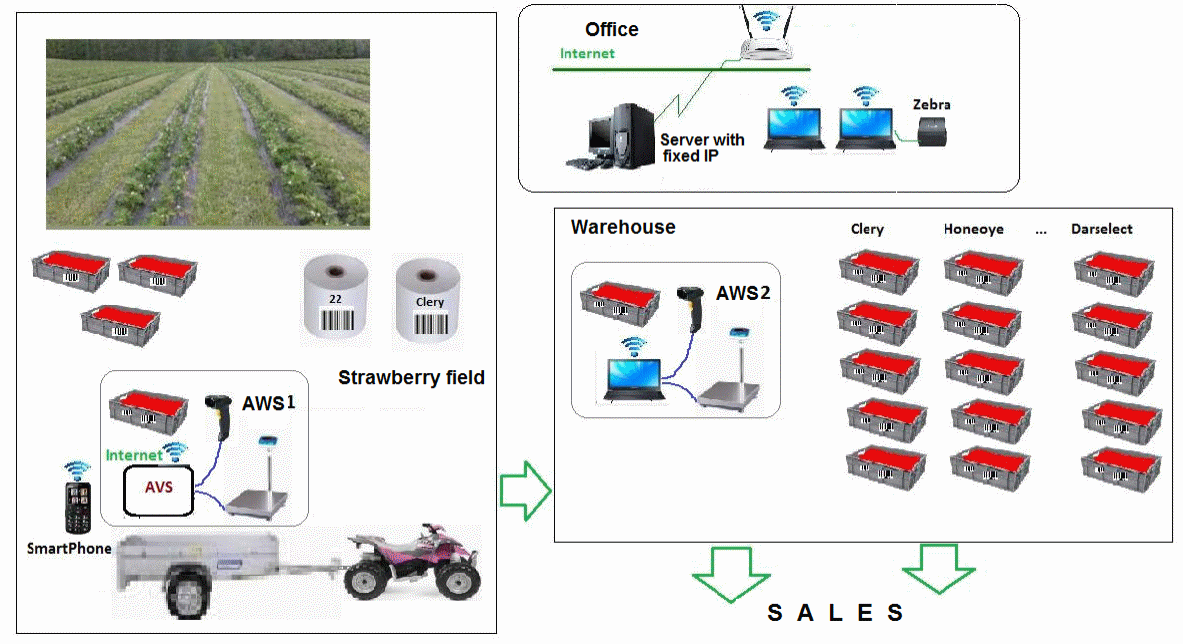
On the left side of Fig. 8 shows that an ATV arrives in the field with a trailer with a floor scale, a bar code scanner and an AVS electronic block. In advance, each strawberry picker (possibly other berries or vegetables) was given a roll of labels with the picker's unique barcode (code 22 in Fig. 8). Picker's barcodes are printed at the enterprise office on a Zebra-type printer. When the picker fills the boxes with berries or vegetables, he places them on the lane between the furrows and sticks his barcode sticker to each box. When the foreman in charge of transporting the crop to the warehouse places boxes filled with one picker on the scale, he also sticks a label for the type of berries or vegetables to each box. These stickers are also pre-printed in the office. The AVS electronic unit connects the scale and scanner to the enterprise server or to the cloud. The program that controls the weighing and movement of products in the warehouse, as well as determines in which field the berries or vegetables were harvested, works on a Smart Phone or Wi-Fi connected to internet Tablet in any operating system. The program operator, having read the product and collector codes with a hand scanner, also informs the program how many boxes are on the scales, and gives the command "Weigh". The net weight of the product is transferred to the warehouse, as the weight of the Tare boxes is subtracted from the total weight.
In a similar way, other warehouse documents are created on AWP2 (Automated Workplace) organized in the local network of the enterprise. If a buyer of berries or vegetables is selected, boxes with products are placed on the scales and one item of an outgoing invoice is created after scanning the product code and entering it using the "Weigh" command. The product code is used, which has already been pasted on the box in the field. It is also necessary to enter the number of boxes to determine the Net weight of the product.
AWS2 can also be used to create internal documents for the transfer, write-off and production of products if the enterprise is processing its crop.
Pic.9
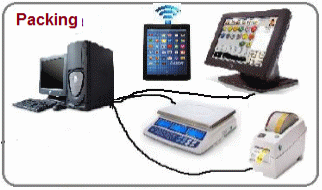
The picture shows that a touch screen, a simple trade scale, and a barcode printer are connected to a desktop computer in a enterprise packaging department, warehouse, or store. Instead of a touchscreen, you can use a tablet with a wireless connection to computer.
The warehouse program AVS has a database with the parameters of the goods - name, expiration date, composition and other parameters. Such a simple and inexpensive technical scheme can be used to mark:
- packages of goods of fixed weight
Pic. 10
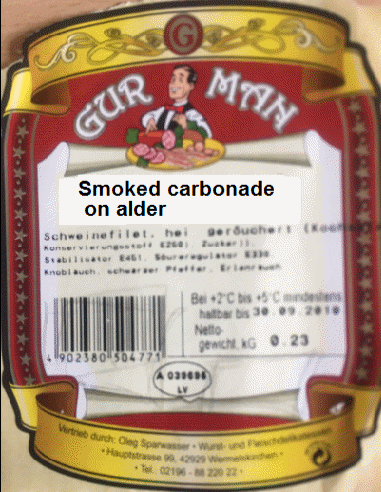
In pic. 10 shows a marker that is printed on a previously prepared label tape in the printing house. The program receives the following information: product name, composition, shelf life, storage conditions, raw material origin code and registration number of the abattoir.
- if the goods have a variable weight, they are placed on the scales. The bar code is then generated in accordance with GS1 rules and the code starts with the number 2;
- the company can also print price tags using this technical scheme. The price tag is printed with the unit price of the piece goods. In this case, the price for 1 kg of packed goods is calculated and printed in accordance with the rules of trade.
The use of such bench top scales is beneficial for small businesses in the food industry and shops, where labeling of piece and packaging with variable weight, as well as printing of price tags occurs in small quantities.
